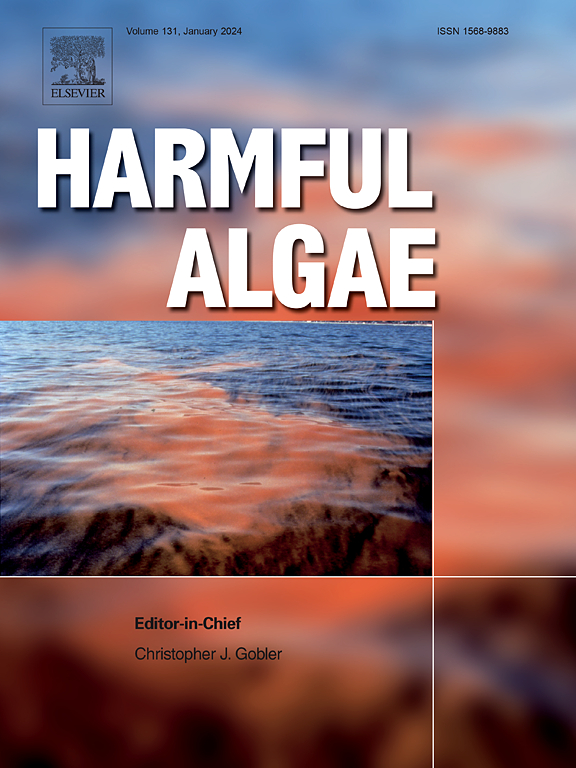Integrated physiological and transcriptomic analysis reveals mechanism of planktonic dinoflagellate Gymnodinium catenatum response to heat and cold stress
IF 4.5
1区 生物学
Q1 MARINE & FRESHWATER BIOLOGY
引用次数: 0
Abstract
The paralytic shellfish toxin-producing dinoflagellate Gymnodinium catenatum is distributed worldwide and often forms massive blooms in coastal waters, which pose a major threat to economic development and human safety. Temperature is among the factors influencing the growth and toxin production of HABs species. However, the physiological and molecular responses of G. catenatum to cold and heat stress need more investigations. Here, we compared the growth, toxin production, and transcriptomes of G. catenatum (Xiamen Bay, China) at different temperatures. Both cold (15°C) and heat (30°C) stress suppressed the growth and chlorophyll a content of G. catenatum. Transcriptomic analysis revealed that carbon from growth-related processes was redirected toward fatty acid synthesis to enhance energy storage under cold stress; up-regulated cold shock proteins and RNA-binding proteins maintained the stability of nucleic acids. Antioxidant activity was enhanced under heat stress with energy and carbon skeletons derived from the light reaction and starch and leucine degradation. The increase in toxin production probably stemmed from the enhanced transcription of core toxin synthesis genes and the inhibition of cell division under cold stress, whereas heat stress markedly enhanced the expression of genes involved in toxin synthesis. This enhanced the ability of G. catenatum to survive over a range of temperatures, and the increased frequency and toxicity of its blooms have significant ecological and economic implications under future global warming.

综合生理和转录组学分析揭示了浮游鞭毛藻裸子对冷热胁迫的响应机制
麻痹性贝类毒素甲藻裸鞭毛虫(Gymnodinium catenatum)分布在世界各地,常在沿海水域形成大规模水华,对经济发展和人类安全构成重大威胁。温度是影响赤潮藻生长和产毒的因素之一。然而,对冷、热胁迫的生理和分子反应还有待进一步研究。在这里,我们比较了中国厦门湾的G. catenatum在不同温度下的生长、毒素产生和转录组。冷(15°C)和热(30°C)胁迫均抑制了悬连藤的生长和叶绿素a含量。转录组学分析表明,来自生长相关过程的碳被重定向到脂肪酸合成中,以增强冷胁迫下的能量储存;冷休克蛋白和rna结合蛋白的上调维持了核酸的稳定性。热应激条件下,光反应产生的能量和碳骨架以及淀粉和亮氨酸的降解增强了抗氧化活性。毒素产量的增加可能源于冷胁迫下核心毒素合成基因转录的增强和细胞分裂的抑制,而热胁迫则显著增强了毒素合成相关基因的表达。这增强了G. catenatum在一定温度范围内的生存能力,并且在未来全球变暖的情况下,其繁殖频率和毒性的增加具有重要的生态和经济意义。
本文章由计算机程序翻译,如有差异,请以英文原文为准。
求助全文
约1分钟内获得全文
求助全文
来源期刊

Harmful Algae
生物-海洋与淡水生物学
CiteScore
12.50
自引率
15.20%
发文量
122
审稿时长
7.5 months
期刊介绍:
This journal provides a forum to promote knowledge of harmful microalgae and macroalgae, including cyanobacteria, as well as monitoring, management and control of these organisms.
 求助内容:
求助内容: 应助结果提醒方式:
应助结果提醒方式:


